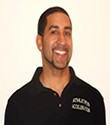Top Two Ways Monitoring Can Make a Positive Impact
In part 1 and part 2 of this blog, I discussed three things: why we monitor, considerations for monitoring and how we monitor at the high school level.
In this blog, I am going to outline the top 2 ways in which monitoring can be applied to make a positive impact in your program.
#1: Relationships
 Relationships are paramount at any level, but especially at the high school level. High school age athletes are very impressionable, and it is a great time to have a major impact on their lives.
Relationships are paramount at any level, but especially at the high school level. High school age athletes are very impressionable, and it is a great time to have a major impact on their lives.
Different monitoring methods present the opportunity to ask questions and develop deeper relationships with your athletes.
Here are some example question scenarios:
- I see you slept 4 hours? Is there something going on I can help with?
- Your academic stress was rated high yesterday? Is school pretty tough right now?
- I see you rated practice hard yesterday. Are you feeling sore?
Simple questions like this give great insight into where your athletes are physically, mentally and emotionally.
Pro Tip: Using these techniques have always allowed me to get to know my athletes on a deeper level, and help meet them where they are from a training standpoint.
These interactions with your athletes should be a daily ritual for you as a coach.
#2: Training Adjustments (Off the Script)
Monitoring allows the coach to make educated decisions on what the training day should look like.
There is a time and a place to push through adversity, but it is not every time you train. There must be an ebb and flow to your training.
We use an APRE/RPE method to account for readiness that I detailed in the blog Monitoring Part 2 – Monitoring Tools that Every Coach Needs.
Volume, intensity and exercise manipulation can also be used to help reduce stress in a session.
Pro Tip: Here is an example on how we adjust training volume that would be used to account for the fatigue of the athlete.
Original Workout
| Power Clean | 6×3 |
| Front Squat | 5×5 |
| DB Bench Press | 5×10 |
Adjustment (Off the Script) Workout
| Clean Pull | 4×3 |
| Front Squat | 3×5 |
| DB Bench Press | 3×10 |
Pro Tip: Here is an example on how we adjust training intensity that would be used to account for the fatigue of the athlete.
| Lift | Volume | Original % | Adjusted % |
| Power Clean | 6×3 | 60, 65, 75, 80, 85, 90 | 60, 65, 75, 75, 80, 80 |
| Front Squat | 5×5 | 60, 65, 70, 75, 80 | 50, 55, 60, 65, 70 |
Conclusion
Monitoring is only valuable if you apply the information that is collected to benefit your athletes in a useful manner.
The takeaway for monitoring is to make the data you collect work for you in order to make a positive impact on your athletes on a personal as well as physiological level.
I have outlined two ways in which monitoring is extremely beneficial in a fast-paced high school environment. Frequent personal interactions with your athletes will yield large results in the long run, and monitoring presents regular opportunities to make these interactions happen.
Training adjustments that were outlined can be applied to any facet of training including the weight room, speed development or your conditioning program to meet your athletes where they are on any given training day.
About the Author: Fred Eaves
 Fred Eaves
Fred Eaves
– Ed.S, M.Ed, CSCS, RSCC, IYCA, USAW, USATF
– BIOFORCE Conditioning Coach Certified
– 2015 NSCA H.S. Strength Coach of the Year
– 2013 Samson Equipment & AFM H.S. Strength Coach of The Year















